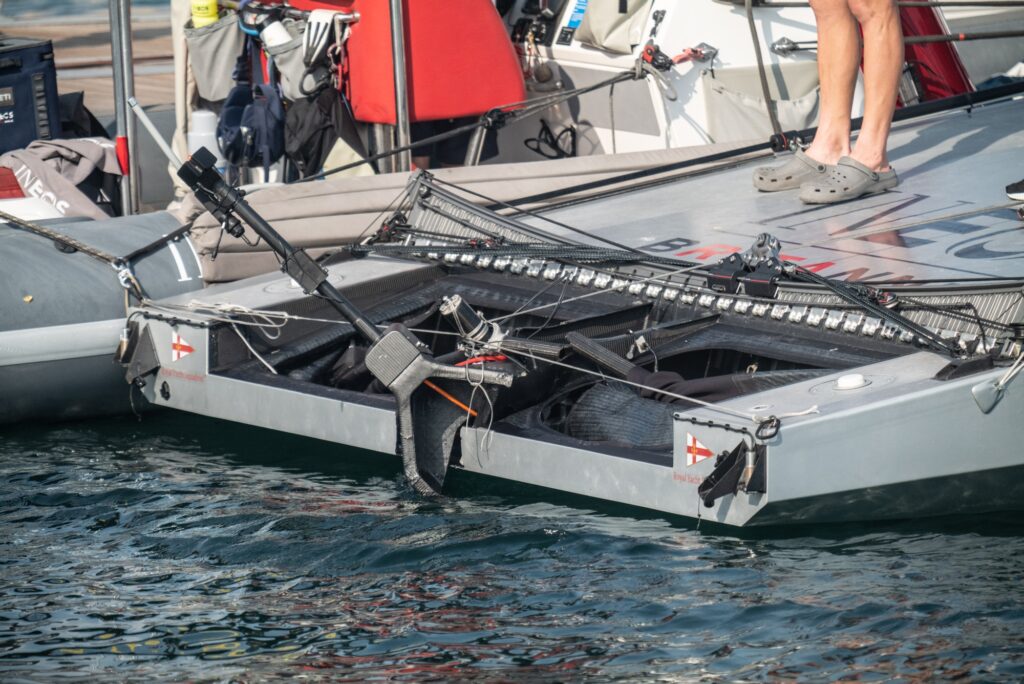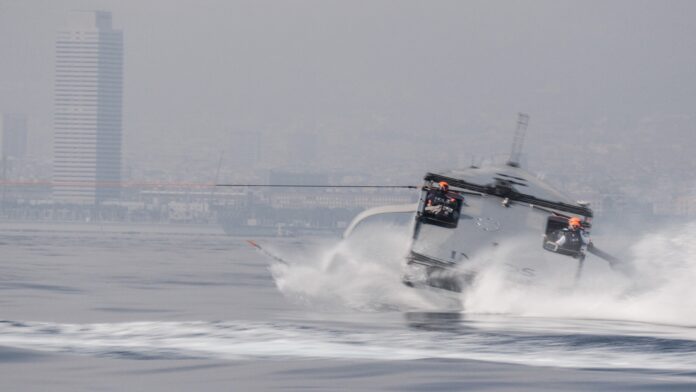“If you’re not innovating and breaking things, you’re probably being too conservative.” The words of Grant Dalton, CEO of Emirates Team New Zealand, spoken in the IMAX video in the America’s Cup Experience Exhibition Centre, will be resonating next door in the Port Vell base of the Challenger of Record, INEOS Britannia as the team suffered a catastrophic rudder failure of T6 whilst out tow-testing on a benign Barcelona Friday.
With no rig up, the British team sensibly opted to make the best of the super-light conditions, concentrating on their hydro performance profile and in particular the rudder under load. On an almost flat calm dancefloor with just a tiny bit of swell running through, the team went through some manual and auto-pilot flight control on the foils at 30 knots, stepping up and down the speed incrementally, with all systems apparently working well.
Then, as the Chase Boat appeared to increase speed slightly, Giles Scott helming from the port aft pod can be seen to be steering to port (confirmed by the movement of the wheel in the starboard pod) and then back to starboard going perhaps as far as lock-to-lock as Luke Parkinson sitting in front of Giles appeared to be checking/securing the orange tow-line.
Suddenly the sailors were passengers in a nasty crash with the rudder stock appearing to bend initially to starboard and then go into a shudder, throwing the bow up and the boat out of control. In a blink of an eye the rudder bent to 45 degrees (It did not snap off) and T6 was spun round some 90 degrees. As the boat came to a stop, Giles Scott and Ben Cornish (alternate side-helm) were quick to jump out of their pods to try and assess damage, standing on the aft run-off of T6 to see if they could define early cause with the twisted rudder head mount before them.

Thankfully no-one was injured in the incident and speaking afterwards, Giles Scott, Head of Sailing, was quick to update about the incident in his usual open and honest manner saying: “We went out to do some to testing today. We took the boat out with no rig, there was some stuff that we wanted to want to look at with the rudder, yeah unfortunately we saw a bit of an ‘extreme load case’ and ended up with some pretty heavy damage and the guys behind me here are getting the boat craned out and there will be a lot of diagnosis that’s going to be needed in terms of working out exactly what happened and why. But we’ll get the boat back in the shed and hopefully be back out soon.”

And he continued: “It happened reasonably quickly and I’m sure the video kind of shows that we were under reasonable control and then there was a failure and we ended up pointing in the wrong direction and in the water. Fortunately, you know no one was hurt and just a bit of boat damage to deal with which is obviously not what we want but the important thing is everyone’s all good.”

Asked whether the team were testing a new, and unseen, system for the rudder control, Giles was quick to set the record straight, saying: “No new steering system. We just had a few things that we wanted to sign off with the rudder and I suppose we knew that today we were pushing to an extreme and unfortunately, we overstepped the mark there, but I think the positive side of it is, albeit destructive data, we’ve got a good point in the data set there and it can only help for RB3 (the team’s new AC75 in construction).”
Clearly some early analysis had been conducted as Giles alluded, but a full investigation will now be underway in this most technically-minded of America’s Cup teams with the full support of the technicians at Mercedes Applied Science and the integrated design office. Giles wouldn’t be drawn but said: “I won’t go into the details, but i think some of the images that you guys have got, and the video is to some extent self-explanatory. I’ll let you let everyone use their imaginations there.”

INEOS Britannia will be eyeing a swift return for T6 but in the meantime they can gain valuable time ahead of the Jeddah Preliminary Regatta at the end of November with the team’s AC40 ‘Athena’ in the shed in Barcelona and ready to go. Giles, albeit a bit sad with the plight of T6, offered: “We’ll have to have look at what T6 is like…we’ve got the AC40 in the shed as well, so we’ll sort out our plan this evening once we’ve got a good idea of how the boat is.”
INEOS Britannia were admirably quick to own the situation with Chief Operating Officer, David Endean explaining the situation on social media saying: So, we had an interesting day on the water in INEOS Britannia. We had our test boat T6 out there and we were doing some rudder testing, and we had a bit of a failure on one of the systems on the back of the yacht that controls the rudder and led to a very sharp 90-degree turn. The good thing is all the guys are okay onboard, so we had no injuries and everyone’s back ashore now and we’re just pulling the boat apart to try and understand what happened and see what the long-term impact for our programme is on ‘T6’. Next week we’ll have the AC40 back on the water and begin our focus towards the next Preliminary event in Jeddah.”

On-Water Recon Unit Report – INEOS Britannia: INEOS Britannia rolled out their T6 test boat at 12:25, delayed from 11:00. The rudder elevator, officially declared Version D as of today, had been exchanged overnight, bearing a resemblance to Version B with a
distinctive trailing bulb behind the elevator. The yacht was craned in at 12:40 without rigging, suggesting hydro testing was the focal point of today’s operations. Two batteries were carried into the foredeck.
Ben Cornish took helm on starboard and Giles Scott on port ahead of the 13:10 dock-out, while Leigh McMillan and Luke Parkinson occupied the starboard and port trimming seats, respectively. The sailing conditions were characterized by a flat sea and wind speed registering below 6 knots.
The yacht was towed eastward at stepped speeds between 20-30 knots, 6.5 Nautical Miles from the port entrance. Throughout this phase, the crew played with ride height and foil arm cant angles, notably without altering the yacht’s pitch. Subsequent to this distance, the team made the decision to return, towing back towards the base.
An incident transpired while foiling under tow at 30 knots, resulting in a spinout of the boat. Immediate observation revealed a failure in the rudder system, specifically a clear breakage in the rudder box. On reviewing the video, the rudder can be seen oscillating progressively more violently until it exceeded load limit. Giles Scott was helming at this moment, and the unmanned steering wheel on starboard can be see shaking aggressively.
It seems that Luke Parkinson attempted to release the towline a few seconds ahead of the incident, however to no avail. The support crew gathered quickly and secured the boat once all crew were confirmed uninjured.
A diver was deployed to inspect below the waterline, then protecting the elevator and securing the rudder with ropes for the tow back to the base, which proceeded at a pace of 3 knots alongside the chase boat.
In a post-testing interview, Giles Scott explained that the team consciously pushed rudder testing to its extremities but acknowledged they “overstepped the mark.” No further technical tests or tweaks were highlighted, and the sailing session concluded with the yacht being towed back to base, docking in at 16:00.






